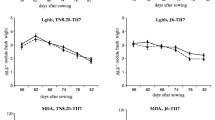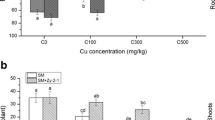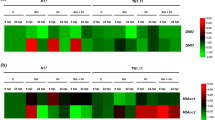Abstract
Symbiosis between plants of family Fabaceae and bacteria genus Rhizobium is the most widespread interaction, in which atmospheric nitrogen is reduced into ammonia. This highly oxygen-sensitive process is performed by endosymbiotc forms of rhizobia called bacteroids, which occupy newly formed plant organs called root nodules. The goal in this paper was to explore the differences in the (ultra)structure and Reactive Oxygen Species (ROS) localization in two symbiotic interactions between legume model plant Medicago truncatula Gaertn. and bacteria from genus Sinorhizobium. Two bacterial strains—Sinorhizobium meliloti 1021 and Sinorhizobium medicae 419 have the ability of inducing root nodules on the Medicago truncatula, however, such nodules differ in effectiveness of biological nitrogen fixation. We demonstrated that root nodules made of S. medicae 419 [fully effective (F++)] induce a lower number of nodule per plant in comparison to S. meliloti 1021—(partially effective F±). Although the differences in the structure are scant, there are some discrepancies in the ultrastructure. In the meristem of F± nodules, there are Cajal bodies and a lower number of vacuole profiles by larger size in comparison to the F++. Nodules F++ have a thicker interzone and store less starch than F+/, while they have higher esterase activity. Localization of different ROS seems to be comparable in the two type of nodules but interestingly, there is not any Nitric Oxide (NO) in the infection thread of F± root nodules.












Similar content being viewed by others
References
Abd-Alla MH, Koyro H-W, Yan F, Schubert S, Peiter E (2000) Functional structure of the indeterminate Vicia faba L. root nodule: implications for metabolite transport. J Plant Physiol 157:335–343
Aneja P, Charles TC (1999) Poly-3-hydroxybutyrate degradation in Rhizobium (Sinorhizobium) meliloti: isolation and characterization of a gene encoding 3-hydroxybutyrate dehydrogenase. J Bacteriol 181:849–857
Apel K, Hirt H (2004) Reactive oxygen species: metabolism, oxidative stress, and signal transduction. Annu Rev Plant Biol 55:373–399
Bala A, Giler KE (2006) Relationships between rhizobial diversity and host legume nodulation and nitrogen fixation in tropical ecosystems. Nutr Cycl Agroecosyst 76:319–330
Baudouin E, Pieuchot L, Engler G, Pauly N, Puppo A (2006) Nitric oxide is formed in Medicago truncatula-Sinorhizobium meliloti functional nodules. Mol Plant Microbe Interact 19:970–975
Becana M, Matamoros MA, Udvardi M, Dalton DA (2010) Recent insights into antioxidant defenses of legume root nodules. New Phytol 188(4):960–976
Bederska M, Znojek E, Borucki W (2012) Movement of fluorescent dyes Lucifer Yellow (LYCH) and carboxyfluorescein (CF) in Medicago truncatula Gaertn. roots and root nodules. Symbiosis 58:183–190
Borucki W (2007) A comparative cytological and morphometric analysis of vacuolation in central tissue of the effective and ineffective pea (Pisum sativum L.) root nodules. Acta Soc Bot Pol 76(2):109–118
Brown SM, Walsh KB (1994) Anatomy of the legume nodule cortex with respect to nodule permeability. Aust J Plant Physiol 21:49–68
Burdon JJ, Gibson AH, Searle SD, Woods MJ, Brockwell J (1999) Variation in the effectiveness of symbiotic associations between native rhizobia and temperate Australian Acacia: within—species interactions. J Appl Ecol 36:398–409
Cam Y, Pierre O, Boncompagni E, Herouart D, Meilhoc E, Bruand C (2012) Nitric oxide (NO): a key player in the senescence of Medicago truncatula root nodules. New Phytol 196(2):548–560
Corpas FJ, Barroso JB, Carreras A, Quiros M, Leon AM, Romero-Puertas MC, Esteban FJ, Valderrama R, Palmo JM, Sandalio LM, Gomez M, del Rio LA (2004) Cellular and subcellular localization of endogenous nitric oxide in young and senescent pea plants. Plant Physiol 136:2722–2733
D’Haeze W, Rycke RD, Mathis R, Goormachtig S, Pagnotta S, Verplancke C, Capoen W, Holsters M (2003) Reactive oxygen species and ethylene play a positive role in lateral root base nodulation of a semiaquatic legume. Proc Natl Acad Sci 100(20):11789–11794
Dalton DA, Joyner SL, Becana M, Iturbe-Ormaexte I, Chatfield JM (1998) Antioxidant defenses in the peripheral cell layers of legume root nodules. Plant Physiol 116:37–43
De Lajudie P, Willems A, Pot B, Dewettinck D, Maestrojuan G, Neyra M, Collins MD, Dreyfus B, Kereters K, Gillis M (1994) Polyphasic taxonomy of rhizobia: emendation of the genus Sinorhizobium and description of Sinorhizobium meliloti comb. nov., Sinorhizobium saheli sp. nov., Sinorhizobium teranga sp. nov. Int J Syst Bacteriol 44:715–733
del Giudice J, Cam Y, Damiani I, Fung-Chat F, Meilhoc E, Bruand C, Brouquisse R, Puppo A, Boscari A (2011) Nitric oxide is required for an optimal establishment of the Medicago truncatula-Sinorhizobium meliloti symbiosis. New Phytol 191:405–417
Escribano RJ (2004) Towards a better understanding of the role of reactive oxygen species in legume root nodules. PhD Thesis, Wageningen, The Netherlands
Forrest SI, Verma DPS, Dhindsa R (1991) Starch content and activities of starch-metabolizing enzymes in effective and ineffective root nodules of soybean. Can J Bot 69:697–701
Fottrell PF (1968) Esterase isoenzymes from legume root nodules. Phytochem 7:23
Fryer MJ, Oxborough K, Mullineaux PM, Baker NR (2002) Imaging of photo-oxidative stress responses in leaves. J Exp Bot 53:1249–1254
Garau D, Reeve WG, Brau L, Deiana P, Yates RJ, James D, Tiwari RP, O’Hara GW, Howieson JG (2005) The symbiotic requirements of different Medicago ssp. suggest the evolution of Sinorhizobium meliloti and E. medicae with hosts differentially adapted to soil pH. Plant Soil 276:263–277
Gechev TS, Van Breusegem F, Stone JM, Denev I, Laloi C (2006) Reactive oxygen species as signals that modulate plant stress responses and programmed cell death. BioEssays 28(11):1091–1101
Graham PH (1992) Stress tolerance in Rhizobium and Bradyrhizobium, and nodulation under adverse soil conditions. Can J Microbiol 38:475–484
Hartmann A, Giraud JJ, Catroux G (1998) Genotypic diversity of Sinorhizobium (formerly Rhizobium) meliloti strains isolated directly from a soil and from nodules of alfalfa (Medicago sativa) grown in the same soils. FEMS Microbiol Ecol 25:107–116
Hernandez JA, Ferrer MA, Jimez A, Barcelo AR, Sevilla F (2001) Antioxidant systems and O2-/H2O2 production in the apoplast of pea leaves. Its relation with salt-induced necrotic lesions in minor veins. Plant Physiol 127:817–831
Hirel B, Le Gouis J, Ney B, Gallais A (2007) The challenge of improving use efficiency in crop plants: towards a more central role for genetic variability and quantitative genetics within integrated approaches. J Exp Bot 58(9):2369–2387
Hirsch AM (1992) Developmental biology of legume nodulation. New Phytol 122:211–237
Hodge A, Robinson D, Fitter A (2000) Are microorganisms more effective than plants at competing for nitrogen? Trends Plant Sci 5:304–308
Hoefel D, Grooby WL, Monis PT, Andrews S, Saint CP (2003) A comparative study of carboxyfluorescein diacetate and carboxy-fluorescein diacetate succinimidyl ester as indicators of bacterial activity. J Microbiol Methods 52:379–388
Horchani F, Prevot M, Boscari A, Evangelisti E, Meilhoc E, Bruand C, Raymond P, Boncompagni E, Ascgi-Smiti S, Puppo A (2011) Both plant and bacterial nitrate reductase contribute to nitric oxide production in Medicago truncatula nitrogen-fixing nodules. Plant Physiol 155:1023–1036
Howieson JG, Loi A, Carr SJ (1995) Biserrula pelecinus L—a legume pasture species with potential for acid, duplex soils which is nodulated by unique root-nodule bacteria. Aust J Agric Res 46:997–1009
Karnovsky MJ (1965) A formaldehyde-glutaraldehyde fixative of high osmolality for use in electron microscopy. J Cell Biol 27:137A-138A
Kazmierczak T, Nagymihaly M, Lamouche F, Barriere Q, Guefrachi I, Alunni B, Ouadghiri M, Ibijbijen J, Kondorosi E, Mergaert P, Gruber V (2017) Specific host-responsive associations between Medicago truncatula accessions and Sinorhizobium strains. Mol Plant Microbe Interact 30(5):399–409
Łotocka B, Kopcińska J, Golinowski W (1997) Morphogenesis of root nodules in white clover. I. Effective root nodules induced by the wild type Rhizobium leguminosarum biovar. trifolii. Acta Soc Bot Pol 66:273–292
Ma F, Peterson CA (2001) Development of cell wall modifications in the endodermis and exodermis of Allium cepa roots. Can J Bot 79:621–634
Masclaux-Daubresse C, Daniel-Vedele F, Dechorgnat J, Chardon F, Gaufichon L, Suzuki A (2010) Nitrogen uptake, assimilation and remobilization in plants: challenges for sustainable and productive agriculture. Ann Bot 105:1141–1157
Matamoros M, Dalton DA, Ramos J, Clemente MR, Rubio MC, Becana M (2003) Biochemistry and molecular biology of antioxidants in the rhizobia-legume symbiosis. Plant Physiol 133:499–509
Minchin FR (1997) Regulation of oxygen diffusion in legume nodules. Soil Biol Biochem 29(5/6):881–888
Mishustin EN, Shil’nikova VK (1971) Biological fixation of atmospheric nitrogen. The Pennsylvania State University Press, Pennsylvania
Morris GE (2008) The Cajal body. BBA Mol Cell Res 1783(11):2108–2115
Murphy PM, Masterson CL (1970) Determination of multiple forms of esterases in rhizobium by paper electrophoresis. J Gen Microbiol 61:121–129
Mytton LR (1983) Host plant selection and breeding for improved symbiotic efficiency. In: Jones DG, Davies DR (eds) W: The physiology genetics and nodulation of temperate legumes. Pitman, Londyn, pp 373–393
Ortega-Villasante C, Rellan-Alvarez R, Del Campo FF, Carpena-Ruiz RO, Hernandez LE (2005) Cellular damage induced by cadmium and mercury in Medicago sativa. J Exp Bot 56(418):2239–2251
Parker MA (1999) Mutualism in metapopulations of legumes and rhizobia. Am Nat 153:48–60
Pauly N, Pucciariello C, Mandon K, Innocenti G, Jamet A, Baudouin E, Herouart D, Frendo P, Puppo A (2006) Reactive oxygen and nitrogen species and glutathione: key players in the legume-rhizobium symbiosis. J Exp Bot 57(8):1769–1776
Puppo A, Groten K, Bastian F, Carzaniga R, Soussi M, Lucas MM, de Felipe MR, Harrison J, Vanacker H, Foyer CH (2005) Legume nodule senescence: roles for redox and hormone signaling in the orchestration of the natural aging process. New Phytol 165:683–701
Rangin C, Brunel B, Cleyet-Marel JC, Perrineau MM, Bena G (2008) Effects of Medicago truncatula genetic diversity, rhizobial competition, and strain effectiveness on the diversity of a natural Sinorhizobium species community. Appl Environ Microbiol 74(18):5653–5661
Rees DC, Tezcan FA, Haynes CA, Walton MY, Andrade S, Einsle O, Howard JB (2005) Structural basis of biological nitrogen fixation. Philos Trans R Soc 363:971–984
Reynolds ES (1963) The use of lead citrate a high pH as an electron opaque stain in electron microscopy. J Cell Biol 17:208–212
Rome S, Brunel B, Normand P, Fernandez MP, Cleyet-Marel JC (1996) Evidence that two genomic species of Rhizobium are associated with Medicago truncatula. Arch Microbiol 165:285–288
Roponen I (1970) The effect of darkness on the leghemoglobin content and amino acid level in the root nodules of pea plants. Physiol Plant 23:452–460
Santos R, Herouart D, Puppo A, Touati D (2000) Critical protective role of bacterial superoxide dismutase in rhizobium-legume symbiosis. Mol Microiol 38:750–759
Santos R, Herouart D, Sigaud S, Touati D, Puppo A (2001) Oxidative burst in alfalfa—Sinorhizobium meliloti symbiotic interactions. Mol Plant Microbe Interact 14:86–89
Scheler C, Durner J, Astier J (2013) Nitric oxide and reactive oxygen species in plant biotic interactions. Curr Opin Plant Biol 16:534–539
Schultze M, Kondorosi A (1998) Regulation of symbiotic root nodule development. Annu Rev Gen 32:33–57
Shaw SL, Long SR (2003) Nod factor inhibition of reactive oxygen efflux in a host legume. Plant physiol 132:2196–2204
Simsek S, Ojanen-Reuhs T, Stephens SB, Reuhs BL (2007) Strain-ecotype specificity in Sinorhizobium meliloti—Medicago truncatula symbiosis is correlated to succinoglucan oligosaccharide structure. J Bacteriol 189:7733–7740
Sprent JI, Sprent P (1990) Nitrogen fixing organisms. Pure and Applied Aspects, Chapman and Hall, p 256
Sujkowska-Rybkowska M (2012) Reactive oxygen species production and antioxidative defense in pea (Pisum sativum L.) root nodules after short-term aluminum treatment. Acta Physiol Plant 34:1387–1400
Sujkowska M, Górska-Czekaj M, Bederska M, Borucki W (2011) Vacuolar organization in the nodule parenchyma is important for the functioning of pea root nodules. Symbiosis 54:1–16
Terpolilli JJ (2009) Why are the symbioses between some genotypes of Sinorhizobium and Medicago suboptimal for N2 fixation? PhD Thesis, Murdoch University
Terpolilli JJ, O’Hara GW, Tiwari RP, Dilworth MJ, Howieson JG (2008) The model legume Medicago truncatula A17 is poorly matched for N2 fixation with the sequenced microsymbiont Sinorhizobium meliloti 1021. New Phytol 179:62–66
Thrall PH, Burdon JJ, Woods M (2000) Variation in the effectiveness of symbiotic associations between native rhizobia and temperate Australian legumes: within and among genera interaction. J Appl Ecol 37:52–65
Van de Velde W, Guerra JC, De Keyser A, De Rycke R, Rombauts S, Manoury N, Mergaert P, Kondorosi E, Holsters M, Goormachtig S (2006) Aging in legume symbiosis. A molecular view on nodule senescence in Medicago truncatula. Plant Physiol 141:711–720
Van de Wiel C, Norris JH, Bocfaenek B, Dickstein R, Bisseling T (1990) Nodulin gene expression and ENOD2 localization in effective, nitrogen-fixing and ineffective, bacteria-free nodules of alfalfa. Plant Cell 2:1009–1017
Vance CP (1998) Nodule carbon metabolism: organic acid for N2 fixation. In: Elemrich C, Kondorosi A, Newton W (eds) Biological nitrogen fixation for the 21st century. Kluwer, Dordrecht
Vance CP, Johnson LEB (1983) Plant determined ineffective nodules in alfalfa (Medicago sativa): structural and biochemical comparisons. Can J Bot 61:93–106
Vasse J, Billy F, Camut S, Truchet G (1990) Correlation between ultrastructural differentiation of bacteroids and nitrogen fixation in alfafa nodules. J Bacteriol 8:4295–4306
Veereshlingam H, Haynes JG, Penmetsa RV, Cook DR, Sherrier DJ, Dickstein R (2004) nip, a symbiotic Medicago truncatula mutant that forms root nodules with aberrant infection threads and plant defense-like response. Plant Physiol 136:3692–3702
Villegas MDC, Rome S, Maure L, Domergue O, Gardan L, Bailly X, Cleyet-Morel JC, Brunel B (2006) Nitrogen-fixing sinorhizobia with Medicago laciniata constitute a novel biovar (bv. Medicaginis) of S. meliloti. Syst Appl Microbiol 29:526–538
Walsh KB (1995) Physiology of the legume nodule and its response to stress. Soil Biol Biochem 27:637–655
Wang K, Kang L, Anand A, Lazarovits G, Mysore KS (2007) Monitoring in planta bacterial infection at both cellular and whole-plant levels using the green fluorescent protein variant GFPuv. New Phytol 174:212–223
West SA, Kiers ET, Simms EL, Denison RF (2002) Sanctions and mutualism stability: why do rhizobia fix nitrogen? Proc R Soc Lond B 685–694
Wood SM, Layzell DB, Newcomb W, Pankhurst CE (1984) A morphometric study of effective nodules induced by Rhizobium loti and Bradyrhizobium sp. (Lotus) on Lotus pedunculatus. Can J Bot 63:43–53
Author information
Authors and Affiliations
Corresponding author
Additional information
Communicated by O. Ferrarese-Filho.
Publisher's Note
Springer Nature remains neutral with regard to jurisdictional claims in published maps and institutional affiliations.
Rights and permissions
About this article
Cite this article
Bederska-Błaszczyk, M., Sujkowska-Rybkowska, M. & Borucki, W. Sinorhizobium medicae 419 vs S. meliloti 1021: differences in root nodules induced by these two strains on the Medicago truncatula host. Acta Physiol Plant 43, 7 (2021). https://doi.org/10.1007/s11738-020-03166-1
Received:
Revised:
Accepted:
Published:
DOI: https://doi.org/10.1007/s11738-020-03166-1




